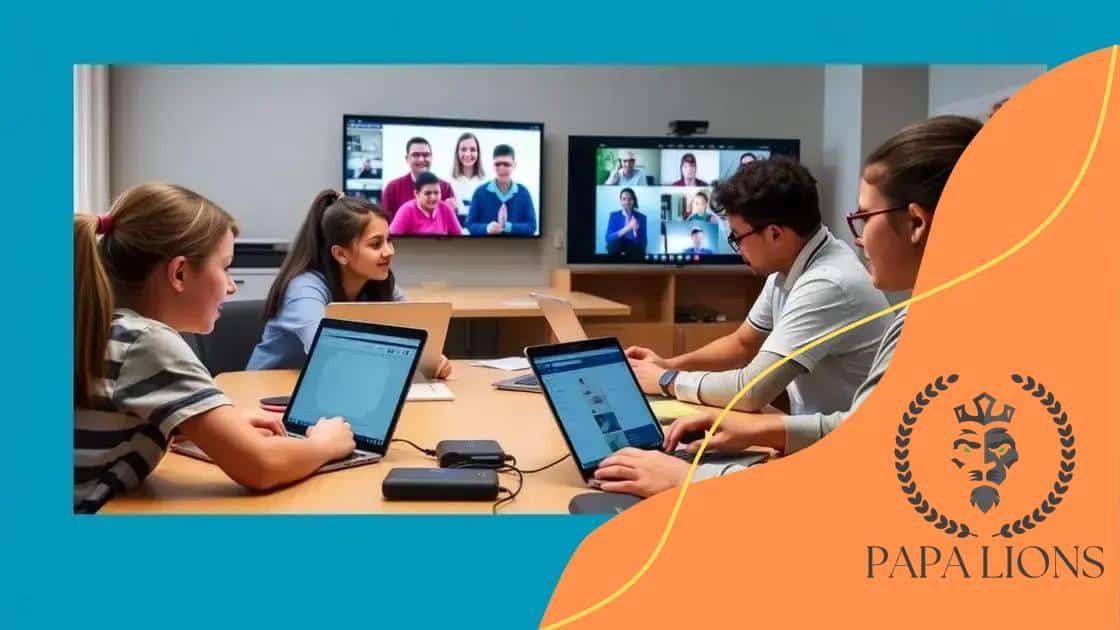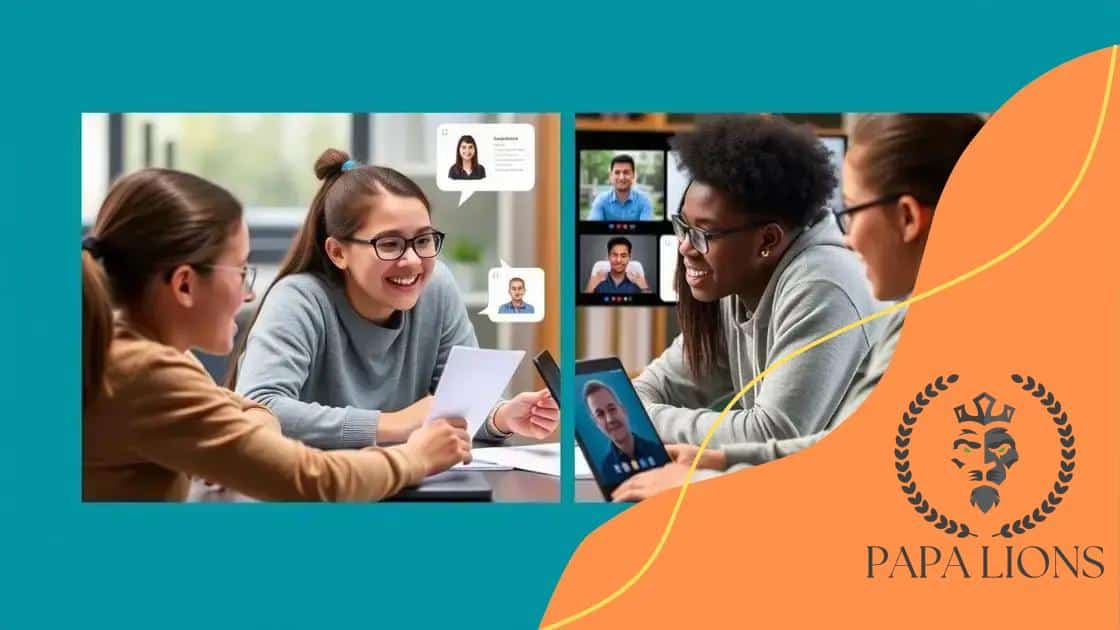The impact of virtual classrooms on student collaboration

The impact of virtual classrooms on student collaboration includes enhanced engagement through technology, improved communication with collaborative tools, and the ability to overcome geographic barriers, transforming how students interact and learn.
The impact of virtual classrooms on student collaboration is profound, opening up new ways for students to work together. Have you noticed how learning has evolved with technology? Let’s dive into how these changes influence teamwork and skills.
Understanding virtual classrooms
Understanding virtual classrooms is essential for recognizing their impact on education today. These online environments facilitate learning through technology, allowing students to connect from anywhere.
What are Virtual Classrooms?
A virtual classroom is an online space where teachers and students interact using tools like video conferencing and chat. They make learning flexible and accessible, which is vital in our tech-driven world.
Key Features of Virtual Classrooms
- Interactive Tools: Features like quizzes and polls enhance engagement during lessons.
- Collaboration Opportunities: Students can work together in real-time, regardless of their location.
- Resource Sharing: Teachers can easily share materials, such as slides or documents.
- Recording Options: Lessons can be recorded for later review, accommodating different learning paces.
As education continues to evolve, virtual classrooms are becoming increasingly important. They offer the chance to learn in diverse ways while adapting to each student’s needs.
Moreover, instructors can utilize various multimedia resources to make lessons more engaging. This approach allows students to grasp complex topics through interactive content rather than relying solely on textbooks.
Benefits for Students
For students, the flexibility that virtual classrooms provide is unmatched. They can attend lessons at their convenience and still participate actively. This method promotes a sense of community through discussion forums and group projects.
Additionally, students develop vital skills like time management and self-discipline by navigating their learning schedules independently. As a result, they are better prepared for future challenges.
The role of technology in collaboration
The role of technology in collaboration is significant, especially in virtual classrooms. Modern tools enhance communication and facilitate teamwork among students.
Key Technologies in Collaboration
Several technologies are essential for fostering collaboration. Tools like video conferencing, collaborative software, and messaging apps play vital roles in connecting students.
- Video Conferencing: Programs such as Zoom and Google Meet allow real-time interaction, enabling discussions and group projects.
- Collaborative Software: Platforms like Google Docs and Microsoft Teams let multiple users edit and share documents simultaneously.
- Messaging Apps: Tools like Slack and Discord provide channels where students can communicate efficiently and share resources.
These technologies not only streamline communication but also encourage students to engage more actively in their learning process. They can work together on projects, fostering a strong sense of community.
Moreover, technology reduces geographical barriers. Students from different locations can collaborate as if they were in the same room. This accessibility opens doors to diverse perspectives and ideas.
The Impact on Learning
The impact of technology on learning is profound. Students who use these tools often report higher levels of satisfaction and involvement. They benefit from interactive lessons that keep them engaged.
As technology continues to evolve, so do the ways students collaborate. The future of education lies in adapting these tools to meet learners’ needs effectively, ensuring everyone can participate and contribute.
Benefits of collaborative tools

The benefits of collaborative tools are numerous, particularly in virtual classrooms. These tools enhance how students interact and work together on projects, promoting engagement and productivity.
Enhanced Communication
Effective communication is vital for successful collaboration. Collaborative tools allow students to communicate instantly, share ideas, and provide feedback.
- Real-Time Interaction: Tools like chat and video conferencing foster immediate dialogue, helping to clarify misunderstandings and facilitate brainstorming.
- Increased Accessibility: Students can access projects and resources from anywhere, making it easier to contribute regardless of location.
- Document Sharing: Platforms like Google Drive enable students to share important files easily, promoting teamwork.
Such features create an environment where everyone feels included and valued, which can lead to higher-quality work.
Improved Learning Outcomes
Using collaborative tools can also lead to better learning outcomes. When students work together, they can learn from each other’s strengths and perspectives.
This collaboration encourages critical thinking and problem-solving skills. By discussing concepts and challenging each other’s ideas, students reinforce their understanding.
Moreover, collaborating in a virtual setting helps prepare students for real-world teamwork scenarios. They gain essential skills that employers seek, such as communication, flexibility, and the ability to work in diverse teams.
Ultimately, the integration of collaborative tools not only enhances academic performance but also equips students with vital life skills that extend beyond the classroom.
Challenges faced in virtual collaboration
Challenges faced in virtual collaboration can affect the learning experience. While many advantages exist, there are also obstacles that need attention for successful teamwork.
Technical Issues
One common challenge is technical difficulties. Poor internet connectivity can disrupt learning and frustrate students.
- Slow Connections: A sluggish internet can lead to delays during video calls, making communication difficult.
- Software Glitches: Technical issues with software tools can hinder access to shared documents and resources.
- Device Limitations: Not all students have access to computers or tablets, which can create unequal opportunities.
These issues can affect how students interact and collaborate, leading to miscommunication and a lack of engagement.
Communication Barriers
Another significant challenge is communication barriers. Effective communication is key to teamwork, but virtual settings can complicate this.
Body language and other non-verbal cues are often lost in virtual interactions. This can lead to misunderstandings and conflict among team members.
Additionally, time zone differences can create delays in responses, making it harder for students to work together efficiently. Each participant may have different schedules, which can hinder collaboration.
Social Isolation
Social isolation is a concern as well. In face-to-face classrooms, students build connections naturally. In virtual settings, this can be more difficult.
Students may feel disconnected or lonely when working online. This lack of social interaction can impact their motivation and overall learning experience.
Despite these challenges, finding ways to overcome them is essential. Addressing technical issues, enhancing communication strategies, and fostering social connections are crucial for effective virtual collaboration.
Future trends in virtual learning environments
The future trends in virtual learning environments are constantly evolving. As technology progresses, the way students interact and learn online continues to change.
Increased Use of Artificial Intelligence
One major trend is the increased use of artificial intelligence (AI). AI can personalize learning experiences for students, adapting lessons based on their individual needs and progress.
- Adaptive Learning: AI tools can analyze a student’s performance and adjust the curriculum accordingly, ensuring they receive support where needed.
- Virtual Assistants: AI-driven chatbots can assist students with questions about coursework, providing instant support.
- Data Analysis: AI systems can track learning patterns and help educators identify areas where students struggle the most.
These innovations make learning more effective and tailored to each student’s pace and style.
Virtual Reality (VR) and Augmented Reality (AR)
Another exciting trend is the integration of virtual reality (VR) and augmented reality (AR) into education. These technologies create immersive experiences that enhance learning.
For example, students can explore historical sites through VR or interact with 3D models of scientific phenomena using AR.
This hands-on approach can lead to better understanding and retention of complex concepts.
Enhanced Collaboration Tools
The rise of enhanced collaboration tools is also significant. As education shifts more online, tools that foster teamwork continue to improve.
New platforms will focus on making collaboration smoother, allowing students to engage and communicate more effectively. Innovations like virtual whiteboards, shared workspaces, and real-time editing capabilities will make group work more productive.
With these advancements, students will be better prepared for future workplaces that emphasize remote collaboration and teamwork.
Overall, the future of virtual learning environments looks promising. As technology integrates with education, students can expect a more interactive, personalized, and collaborative learning experience.
FAQ – Frequently Asked Questions about Virtual Classrooms and Collaboration
What are the main benefits of virtual classrooms for students?
Virtual classrooms enhance student engagement, provide flexibility, and enable personalized learning experiences.
How does technology improve collaboration in virtual learning environments?
Technology offers tools like video conferencing, collaborative software, and instant messaging, which facilitate real-time communication and teamwork.
What challenges do students face in virtual collaboration?
Students may encounter technical issues, communication barriers, and feelings of social isolation, which can hinder their learning experience.
What future trends can we expect in virtual learning environments?
We can expect increased use of AI, integration of VR/AR technologies, and enhanced collaboration tools that promote effective teamwork and personalized education.





